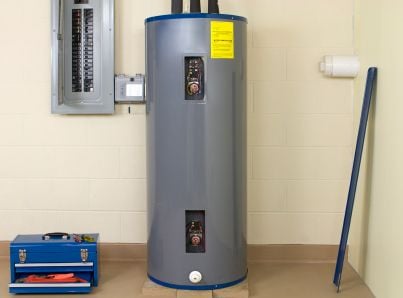Testing and Repairing a Mobile Home's Electric Water Heater

-
2-4 hours
•
-
Intermediate
•
- 25-100
If you're used to taking hot showers in your mobile home, then stepping in one day to find that your water is consistently lukewarm or ice-cold might be a rude awakening. If that happens, you should test your electric water heating element. Robe on, head to the breaker panel with a screwdriver and two meter probes handy.
Many small appliances contain heating elements, which are simply pieces of metal wire that resist a controlled electric current to create heat. The heat stemming from the wires is what your water heater uses to warm your water. If your heating element is broken, it isn't properly converting the electricity flowing to its wires into heat. Heating elements are fairly easy to test and repair; however, you should only attempt either if you are knowledgeable about working with electricity.
Step 1 - Troubleshooting

Find the switch that gives your water heater power, and shut it off. Use the screwdriver to remove the cover(s) (there are usually up to two) over the thermostats and elements. At this point, you should see plastic shields over the element connections – carefully snap these off. You need to be absolutely sure that you don't electrocute yourself, so double-check that you have successfully turned off the water heater's power by setting your meter probe to “volts” and gently touching the probes to the element's screws.
At this point, one of two things should happen: your meter should beep, or its needle should sway way over to the side. If you find that neither of these things happens, then there is no power, and your meter settings are incorrect. Changing your meter setting to “ohms” or “resistance” until you hear a beep or see the needle jump should solve the problem.
At this point, carefully remove the two wires connected to the element. If you're not sure which part of the water heater is the element, keep in mind that most elements are small, rectangular-shaped boxes with screws installed along their edges and two different-colored knobs/buttons at opposite ends. Gently touch the heating element's screws with your meter probes.
Now that you know your meter is working properly, the results from the test should be trustworthy. If the meter beeps or the needle sways to the far side, then your heating element is in fine working condition, and the problem may potentially be caused by a dysfunctional thermostat, which is a whole other can of worms. If your meter does not beep or the needle only moves a tiny bit, it's time to replace your malfunctioning heating element.
If your heating element failed the test, it needs to be replaced. In order to do this yourself, you need to buy a special wrench from either the nearest home improvement store or mobile home repair store. The wrench is specifically designed to remove the element from the water heater.
Some types of water heaters may come with their elements bolted in, thus eliminating the need for a wrench. They are extremely rare in water heaters built for mobile homes. Purchase a new heating element with the same size and wattage of your old one at the same time that you buy the wrench. A new heating element should only cost around $15.
Step 2 - Element Replacement
Now it's time to begin replacing your heating element. First and foremost, turn off the power to your water heater to avoid electrocution. Drain all the water from its tank. If at this point, you find that your heating element is too corroded or in such bad condition that you can't remove it without damaging the water heater itself, then it might be wise to consider purchasing a new water heater entirely.
If your heating element appears to be safe enough to tamper with, remove its wires, then remove the heating element. Install the new heating element which you have purchased at the store. Do not turn the power to the water heater back on until you have first filled its tank back-up with water.
If you turn the power on while the tank is empty, you'll destroy the element that you just installed. After successfully completing these steps in the proper order, your newly fixed water heater should be ready to use.
Step 3 - Thermostat Problems
If the heating element passed the meter probe test, then the problem with your water heater is most likely a malfunctioning upper or lower thermostat. Some mobile home water heaters will contain only one thermostat. That is perfectly normal. In order to test the thermostat, the first step is to remove its metal cover plate and check the status of the high limit switch button.
This button trips when the temperature of the water becomes too hot. In so doing, it shuts off power to any thermostats your heater may have. There is usually a red button which you can press to reset the high limit switch, but it usually means something else is wrong with your water heater when the switch is tripped. The switch should not simply be reset and ignored.
If the button has been tripped, reset it, then use your meter probes to see if the thermostat is transmitting power (sending voltages) to the heating element. If that is the case, and the heating element still is not getting hot, then it is a direct sign that your heating element needs to be replaced. Should you discover that the thermostat is not transmitting power to the heating element at all, then it means your thermostat needs to be replaced.
Restoring hot water to your mobile home's water heater is as easy as self-testing and replacing your heating element or thermostat. Now that you know how, you'll save money on repair fees and enjoy each steaming bath and shower you take.
Hints and help
Additional info




